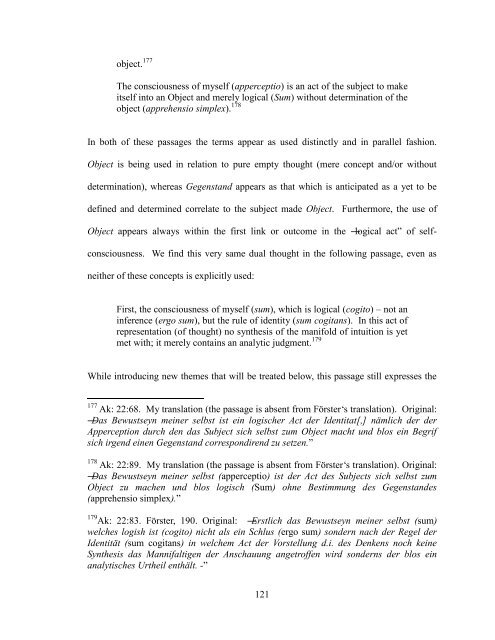The Doctrine of Self-positing and Receptivity in Kant's Late ...
The Doctrine of Self-positing and Receptivity in Kant's Late ...
The Doctrine of Self-positing and Receptivity in Kant's Late ...
You also want an ePaper? Increase the reach of your titles
YUMPU automatically turns print PDFs into web optimized ePapers that Google loves.
object. 177<br />
<strong>The</strong> consciousness <strong>of</strong> myself (apperceptio) is an act <strong>of</strong> the subject to make<br />
itself <strong>in</strong>to an Object <strong>and</strong> merely logical (Sum) without determ<strong>in</strong>ation <strong>of</strong> the<br />
object (apprehensio simplex). 178<br />
In both <strong>of</strong> these passages the terms appear as used dist<strong>in</strong>ctly <strong>and</strong> <strong>in</strong> parallel fashion.<br />
Object is be<strong>in</strong>g used <strong>in</strong> relation to pure empty thought (mere concept <strong>and</strong>/or without<br />
determ<strong>in</strong>ation), whereas Gegenst<strong>and</strong> appears as that which is anticipated as a yet to be<br />
def<strong>in</strong>ed <strong>and</strong> determ<strong>in</strong>ed correlate to the subject made Object. Furthermore, the use <strong>of</strong><br />
Object appears always with<strong>in</strong> the first l<strong>in</strong>k or outcome <strong>in</strong> the ―logical act‖ <strong>of</strong> self-<br />
consciousness. We f<strong>in</strong>d this very same dual thought <strong>in</strong> the follow<strong>in</strong>g passage, even as<br />
neither <strong>of</strong> these concepts is explicitly used:<br />
First, the consciousness <strong>of</strong> myself (sum), which is logical (cogito) – not an<br />
<strong>in</strong>ference (ergo sum), but the rule <strong>of</strong> identity (sum cogitans). In this act <strong>of</strong><br />
representation (<strong>of</strong> thought) no synthesis <strong>of</strong> the manifold <strong>of</strong> <strong>in</strong>tuition is yet<br />
met with; it merely conta<strong>in</strong>s an analytic judgment. 179<br />
While <strong>in</strong>troduc<strong>in</strong>g new themes that will be treated below, this passage still expresses the<br />
177 Ak: 22:68. My translation (the passage is absent from Förster‘s translation). Orig<strong>in</strong>al:<br />
―Das Bewustseyn me<strong>in</strong>er selbst ist e<strong>in</strong> logischer Act der Identitat[,] nämlich der der<br />
Apperception durch den das Subject sich selbst zum Object macht und blos e<strong>in</strong> Begrif<br />
sich irgend e<strong>in</strong>en Gegenst<strong>and</strong> correspondirend zu setzen.‖<br />
178 Ak: 22:89. My translation (the passage is absent from Förster‘s translation). Orig<strong>in</strong>al:<br />
―Das Bewustseyn me<strong>in</strong>er selbst (apperceptio) ist der Act des Subjects sich selbst zum<br />
Object zu machen und blos logisch (Sum) ohne Bestimmung des Gegenst<strong>and</strong>es<br />
(apprehensio simplex).‖<br />
179Ak: 22:83. Förster, 190. Orig<strong>in</strong>al: ―Erstlich das Bewustseyn me<strong>in</strong>er selbst (sum)<br />
welches logish ist (cogito) nicht als e<strong>in</strong> Schlus (ergo sum) sondern nach der Regel der<br />
Identität (sum cogitans) <strong>in</strong> welchem Act der Vorstellung d.i. des Denkens noch ke<strong>in</strong>e<br />
Synthesis das Mannifaltigen der Anschauung angetr<strong>of</strong>fen wird sonderns der blos e<strong>in</strong><br />
analytisches Urtheil enthält. -‖<br />
121


